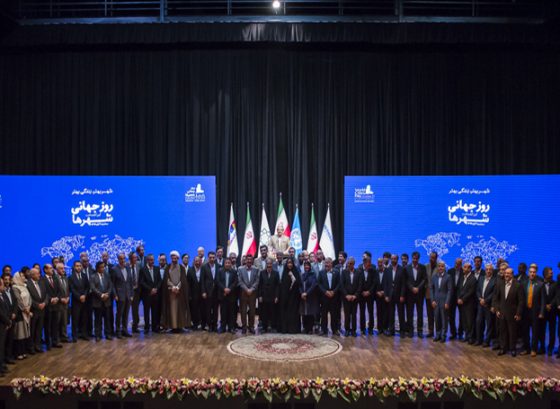“Environment no longer a silent victim of war – Mother Nature is joining the debate”

The international community needs to think increasingly about how environmental factors will become the actual drivers of conflict. And take measures to prevent this, AVA Diplomatic reports.
Speaking recently at a ceremony to mark the world’s need to stop conflicts from despoiling the environment, Gary Lewis, the UN Resident Coordinator in Iran, turned this perspective on its head and urged that there is a greater danger in underestimating the consequences of climate change and resource scarcity on conflict.
“We tend to think that the environment is a perpetual silent victim of war. But Mother Nature is talking back at us. She has joined the debate. And she will win it,” Lewis said.
“Droughts, heatwaves, storms, floods and sea-level-rise are but the beginning of what she has in store for us. And the resulting scarcities of water, food price spikes and unequal resource access may well contribute to weakened state structures and political violence in future – driving migrations, climate refugees and producing insecurity,” he added.
Sixteen years ago, the UN General Assembly declared that every 6 November will be the International Day for Preventing the Exploitation of the Environment in War and Armed Conflict.
To commemorate the day in Iran, the Centre for Peace and Environment in collaboration with the Vice-Presidency for Women and Family Affairs organized the 9th International Seminar on Environmental Consequences of War and Armed Conflict. Lewis was invited to speak at the event.
Lewis focused on the gigatons of CO2 that human activities are pumping into the atmosphere, which – along with other greenhouse gases – are contributing to a warming of the planet that has dramatically disturbed the climate’s natural equilibrium.
Resulting climate change has driven up average global temperatures beyond 1 degree Celsius compared with the pre-industrial average, Lewis noted.
Participants attending Ninth International Seminar on Environmental Consequences of War and Armed Conflict
He drew attention to the now-classic example of Syria, where environmental changes contributed significantly to the start of the ongoing civil war. He noted the severe drought had driven millions of farmers and pastoralists away from the countryside and into Syria’s cities – cities which were ill-equipped to cope with such a sudden inrush of people.
This trend comingled with increasing anger and frustration towards the government amongst the people of the poorest urban areas, where many of the internally-displaced people settled. Protests erupted, he noted, and this was then followed by the violent clashes which eventually led to civil war.
“The role of a hotter, drier climate as a driver of this conflict cannot be over-estimated,” Lewis added.
“What matters as future drivers of climate insecurity is the interplay between energy, water and food,” he continued. “Who will suffer most? As always, people in the developing countries. The women – the poor – and the most vulnerable within those very same countries. But solutions exist,” Lewis said.
In concluding, the UN Resident Coordinator offered what he called five lessons for leaders – both in Iran and beyond.
Lewis began by suggesting that States should start looking at traditional security issues from the “Human Security” angle. Governments needed, he noted, to focus more on ensuring the security of people, and not only of States – this was especially the case as environmental challenges do not respect borders.
Second, was to “improve our knowledge on the impact of climate change through advanced satellite technology and constant climate surveillance”. He also stressed the importance of what he termed, “feedback for applied learning”.
Third, was to develop “transformational” technologies which would help decarbonize the economy quickly. The key goal, he noted, would be to reduce – and eventually eliminate – man-made GHGs, especially CO2 entering the atmosphere and contributing to the greenhouse effect. He praised the emphasis of the administration of President Rouhani on promoting the need for Iran to adopt a low-carbon economy approach.
Lewis’ fourth point stressed the need for international collaboration. He said there was a need to broaden collaborative international planning and emphasize “climate governance”. There was a need, he stressed, to improve environmental dispute resolution capacity in peace-building efforts. Also important was the need to improve trans-boundary resource management approaches, such as those which would be needed to secure solutions for water-basin challenges linked to the Hamouns and Hur-ul Azim systems bordering Iran and, respectively, Afghanistan and Iraq.
Finally, he called for a long-term perspective in reducing the security threat of climate change.
“The ‘dwell time’ for CO2 in the atmosphere will be centuries. We need to think and plan in those terms – or at least in terms of decades. But no longer just years,” Lewis said.
“We need to implement the SDGs – especially those linked to natural resource management and climate change – and engage the private sector in this quest,” he added. “For governments alone cannot do the job. In order to make our current consumption and production patterns sustainable we need to invest trillions, not just billions, in renewables like solar, hydro, wind and geothermal – all of which Iran possesses. The private sector must see a profit potential in joining the march to renewable energy.”
“This is happening,” Lewis said, “but the pace needs to quicken.”




